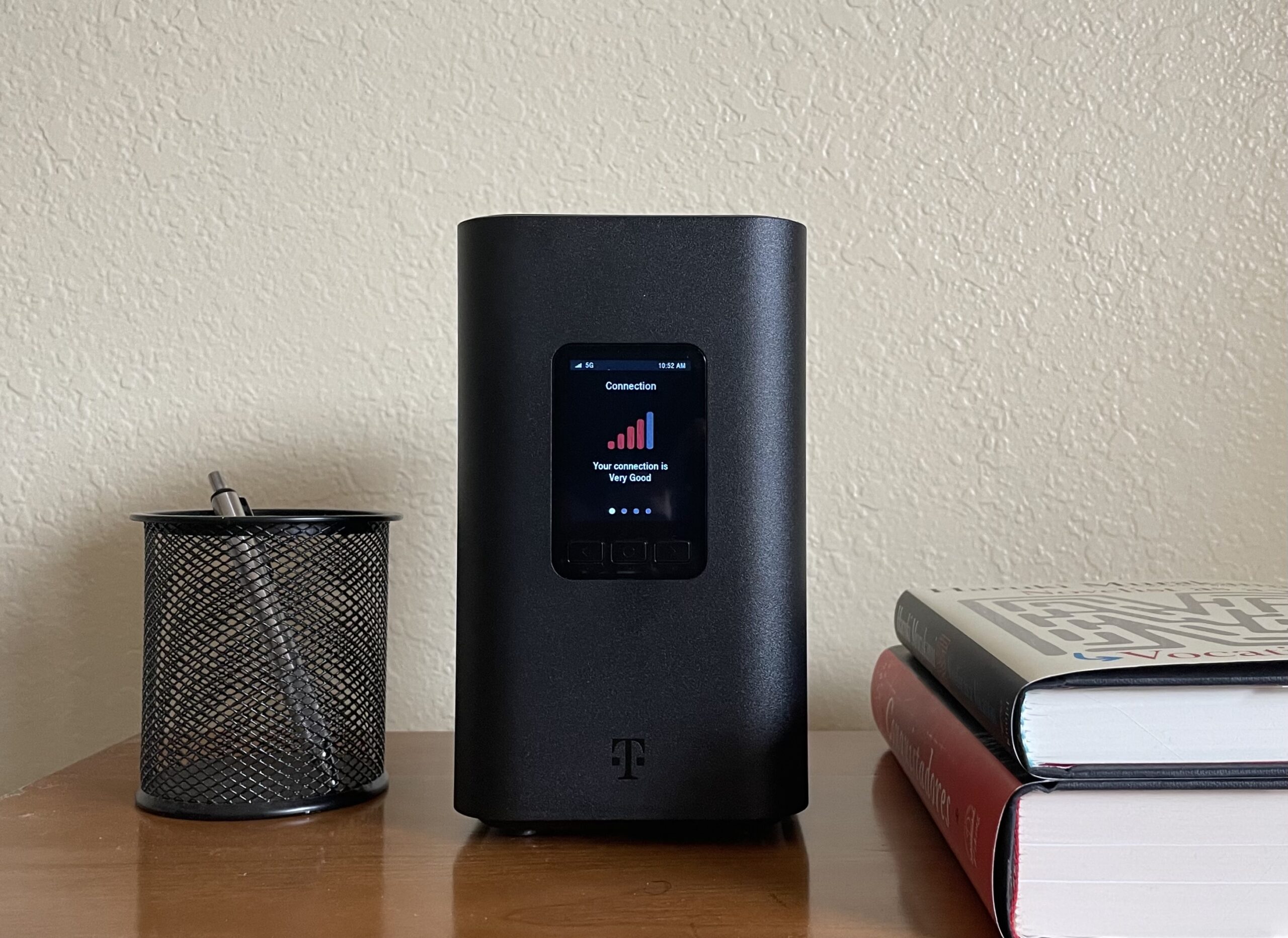What Is Mi-Fi? Here’s What You Need to Know About Portable Internet
May 15, 2025 | Share
Technology
MiFi is wireless internet you can get on the go. A MiFi device is a small router or hotspot that typically works over a cellular connection, using network data to get you a Wi-Fi connection for laptops, tablets, and other devices.
The term “MiFi” originated with the MiFi series of mobile hotspots that were first manufactured by Novatel in the late 2000s. But MiFi has since become a catch-all word for any kind of hotspot or portable router that provides Wi-Fi for connected devices. It’s kind of like how all tissues are Kleenex.
We do tons of research on hotspots at HighSpeedInternet.com, so we’ve put together a quick and handy guide to what MiFi is, how it works, and how you can wield the power of MiFi to your own advantage.
Best MiFi routers and Wi-Fi hotspots
| Product | Price | Connectivity | Max devices | Order online |
|---|---|---|---|---|
| MiFi® X PRO 5G | $264.00 | 5G (mm-wave, C-band), 4G LTE, dual-band 2.4GHz & 5GHz, Wi-Fi 6 | 32 | View on T-Mobile |
| Verizon Inseego MiFi M2100 5G UW | $399.99 | 5G (mm-wave), 4G LTE, dual-band 2.4GHz & 5GHz, 802.11 a/b/g/n/ac | 30 | View on Verizon |
| NETGEAR Nighthawk M1 4G LTE Mobile Router | $319.00 | 4G LTE, dual-band 2.4GHz & 5GHz, 802.11 a/b/g/n/ac | 20 | View on Amazon |
| NETGEAR Nighthawk M6 5G WiFi 6 Mobile Router | $699.99 | 5G (mm-wave, C-band), Wi-Fi 6 (802.11ax) | 32 | View on Amazon |
| Alcatel LINKZONE | $99.99 | 4G LTE, dual-band 2.4GHz & 5GHz, 802.11a/b/g/n/ac | 16 | View on Amazon |
| Huawei E5577-320 4G LTE Mobile WiFi Hotspot | $84.95 | 4G LTE, 802.11n | 10 | View on Amazon |
Data as of 6/21/23. Offers and availability may vary by location and are subject to change. Amazon.com Price as of 1/27/22 10:30 MST. See full disclaimer.
While it’s easiest just to use the hotspot on your phone, mobile hotspots are great if you spend a lot of time using Wi-Fi while traveling or working away from the office. On top of helping preserve your phone’s battery, hotspots deliver faster speeds and support a lot more connections.
Inseego’s MiFi X PRO 5G is perfect for when you’re working at an event or attending a conference, sharing the same Wi-Fi with a group of coworkers or fellow students. A cheaper hotspot like Alcatel’s LINKZONE is better for everyday use, while travel routers like Huawei’s E5577-320 are compatible with cellular carriers in multiple countries.
Pro tip:
To use Wi-Fi while you’re out and about, you need a handheld MiFi hotspot. See our guide to the best hotspots for details on pricing, speeds, and data.
How does MiFi work?
MiFi works by using cellular signals to give you a wireless internet connection. You can get MiFi over a cell phone with built-in tethering functions or through a standalone mobile hotspot with a SIM card and cellular data plan. The device then uses the carrier’s cellular grid to give you a mobile Wi-Fi network wherever cell service is available.
| What you need for MiFi access | Why you need it |
|---|---|
| Hotspot or portable router | Lets you set up the wireless network |
| Cell service (from nearby cell towers) | Provides your Wi-Fi connection |
| SIM card and data plan | Gives you data to use for downloads/uploads |
| Phone, laptop, or other Wi-Fi device | Connects you to the hotspot |
The first device to carry the MiFi name was the Novatel Wireless MiFi 2200, a portable router introduced to the US market in 2009. Wireless technology has advanced considerably since then, and recent developments with 5G suggest MiFi devices may soon become key tools for everyday internet use.
Granted, MiFi–style internet isn’t as cost-effective as a fixed internet connection from a cable or fiber provider—the speeds are slower, and cell carriers put strict limits on the amount of data you can use. But naturally, there are some big advantages to having Wi-Fi access whenever and wherever you want.
Pros of having a MiFi hotspot:
- Gives you internet access while traveling or working remotely
- Lets you bypass slow/insecure public Wi-Fi networks
- Works in remote and rural areas (so long as there’s cell service)
Cons of having a MiFi hotspot:
- More expensive than fixed broadband internet
- Comes with limits on data usage
- Delivers inconsistent speeds
Pro tip:
Can’t afford a hotspot? No problem, you can also find public Wi-Fi at many restaurants, airports, libraries, and even some public parks. Get all the tips on where to find free Wi-Fi if you need internet in a jiffy and don’t have a mobile hotspot on hand.
How fast is MiFi?
| Cellular carrier | 4G LTE avg. download speed | 5G avg. download speed |
|---|---|---|
| AT&T | 38.2 Mbps | 71.1 Mbps |
| Verizon | 31.3 Mbps | 84.9 Mbps |
| T-Mobile | 79.5 Mbps | 186.3 Mbps |
Data from Opensignal’s Mobile Network Experience Report and 5G Experience Report, both from January 2023.
Today you can find MiFi devices capable of delivering gigabit (or near-gigabit) speeds using 5G connections to as many as 20 or 30 devices at once. However, most common hotspots deliver slower speeds, similar to the average Mbps download speeds you can get on 4G LTE phones.
Speeds on a hotspot also vary considerably depending on where you’re using the hotspot. Since you’re getting internet over a wireless signal, performance can be impacted by a range of factors, including geography (like big hills and mountains), inclement weather, and network congestion if you’re in a crowded area.
However, the rise of 5G networks—the latest standard for cellular technology—promises a bigger boost in speeds and greater versatility for MiFi hotspots. Newer 5G hotspots tap into millimeter-wave and C-band channels, which have the capacity to carry larger amounts of data at faster rates, giving you potential speeds of anywhere from 100 to 1,000 Mbps.
Pro tip:
Download our speed test app to figure out if you’re getting adequate speeds on your hotspot.
Pro tip:
Take our speed test to figure out if you’re getting adequate speeds on your hotspot.
If your connection is always lagging, it might be time to upgrade to a 5G device. (We recommend Inseego’s 5G MiFi M2000 because it’s incredibly fast and can connect more than two dozen devices.)
Best MiFi and hotspot data plans
| Plan | Price | Data allowance | Get it |
|---|---|---|---|
| T-Mobile 2GB | $10.00/mo.* | 2 GB/mo. (can order more GB w/ data pass) | |
| Verizon Unlimited Plus | $85.00/mo. | 30 GB of 4G LTE/5G, then reduced to 600 Kbps | View Plan |
| Verizon Pro | $90.00/mo. (or $60.00/mo. w/ Unlimited phone plan) | 100 GB/mo. | View Plan |
| AT&T Prepaid 100 GB | $55/mo. (w/ autopay) | 100 GB/mo. | View Plan |
| Visible+ phone plan | $35.00/mo. | Unlimited (max 10Mbps speeds, connects only one device at a time, speeds may slow after 50GB) |
Data as of 5/15/2025. Offers and availability may vary by location and are subject to change.
*Per connected device with AutoPay. Plus Taxes & fees.
While mobile hotspots and other MiFi gadgets tend to get all the media buzz, the hotspot plan that comes with it is just as important—if not more so. A quality mobile hotspot plan gives you a fair amount of data for the price you pay and provides network coverage over a wide area. Bonus points if you can easily add the plan onto your phone plan through your current cellular provider.
T-Mobile has the best options for hotspot plans. The prices are cheap, and you can simply add on more data when you run out. But rivals Verizon and AT&T have been coming hot on T-Mobile’s heels, increasing data allotments and lowering prices. And as best we can tell, Visible is the only hotspot plan that gives you unlimited data (albeit with some significant caveats).
Fixed wireless internet is another option
If you’re a rural internet user, you can also look into fixed wireless internet options like Verizon LTE Home Internet and T-Mobile Home Internet for more data and better performance. A fixed wireless connection also uses wireless signals to get you internet, but prices tend to be cheaper, and the connection is built more for everyday use.
Use the zip check tool above to see if you can get a fixed wireless setup for your home.
FAQ about MiFi and mobile hotspots
What’s the difference between MiFi and Wi-Fi?
MiFi is a generic branded term that describes any device that can get you a portable internet connection over a wireless signal. Wi-Fi is a technical term that refers to the standards that enable wireless internet access using radio waves.
What’s the difference between a MiFi device and a hotspot?
A MiFi device and a hotspot are basically the same thing. MiFi is the name of Inseego’s series of MiFi mobile hotspots, but people also use the term MiFi to describe hotspot devices made by other brands.
Can you use mobile MiFi in rural areas?
You can definitely use hotspots and other MiFi devices in rural areas as long as you have adequate cell service to support a consistent connection.
MiFi with mobile broadband is a great option for some rural netizens because it costs less than satellite internet, which is often the only other option in remote parts of the United States. Hotspot data plans can be significantly cheaper than satellite plans, while delivering faster speeds and (usually) more data at the same time.
Disclaimer
Product prices and availability are accurate as of the date/time indicated and are subject to change. Any price and availability information displayed on Amazon.com at the time of purchase will apply to the purchase of this product. HighSpeedInternet.com utilizes paid Amazon links.
CERTAIN CONTENT THAT APPEARS ON THIS SITE COMES FROM AMAZON. THIS CONTENT IS PROVIDED ‘AS IS’ AND IS SUBJECT TO CHANGE OR REMOVAL AT ANY TIME.
Author - Peter Holslin
Peter Holslin has more than a decade of experience working as a writer and freelance journalist. He graduated with a BA in liberal arts and journalism from New York City’s The New School University in 2008 and went on to contribute to publications like Rolling Stone, VICE, BuzzFeed, and countless others. At HighSpeedInternet.com, he focuses on covering 5G, nerding out about frequency bands and virtual RAN, and producing reviews on emerging services like 5G home internet. He also writes about internet providers and packages, hotspots, VPNs, and Wi-Fi troubleshooting.
Editor - Rebecca Lee Armstrong
Rebecca Lee Armstrong has more than six years of experience writing about tech and the internet, with a specialty in hands-on testing. She started writing tech product and service reviews while finishing her BFA in creative writing at the University of Evansville and has found her niche writing about home networking, routers, and internet access at HighSpeedInternet.com. Her work has also been featured on Top Ten Reviews, MacSources, Windows Central, Android Central, Best Company, TechnoFAQ, and iMore.







